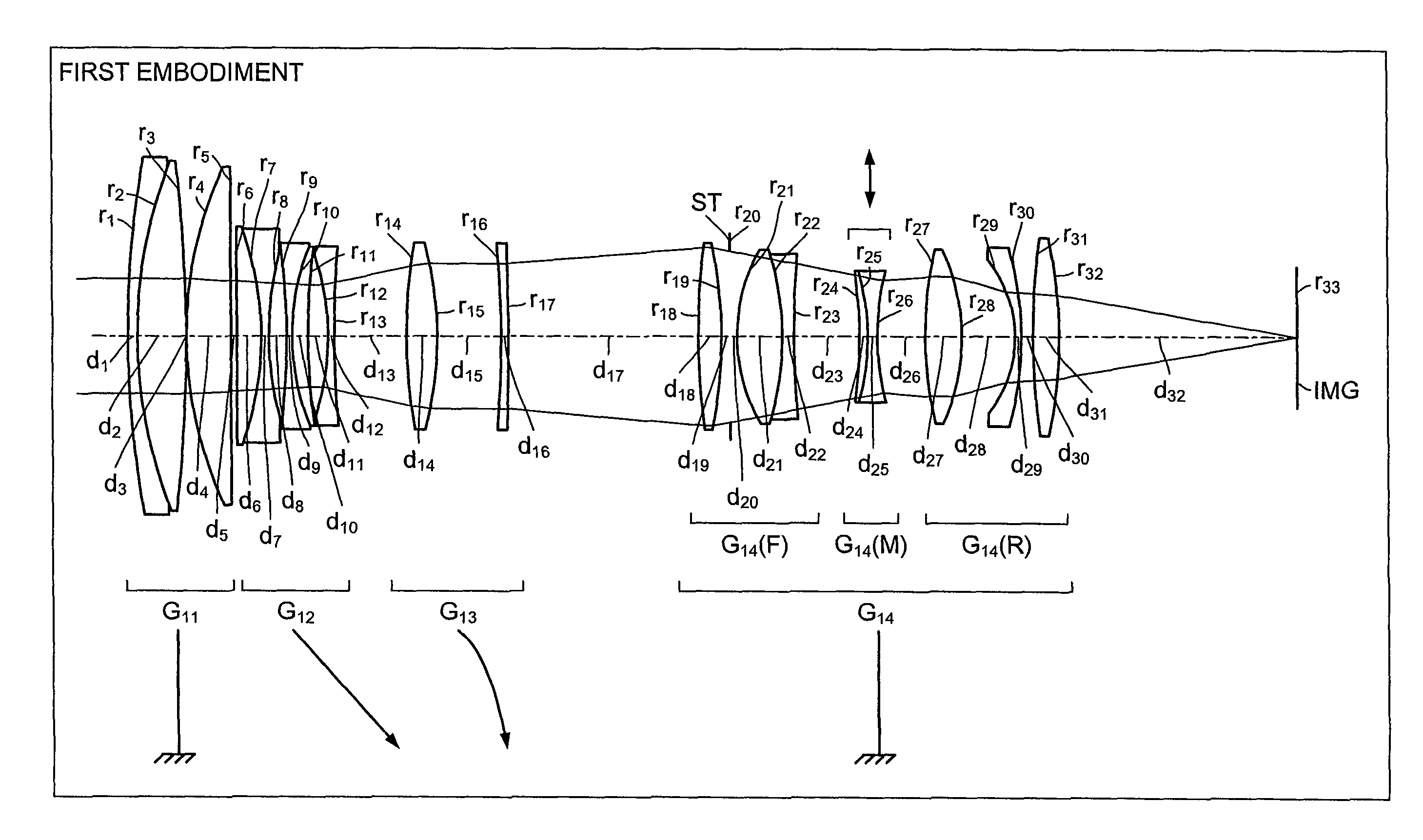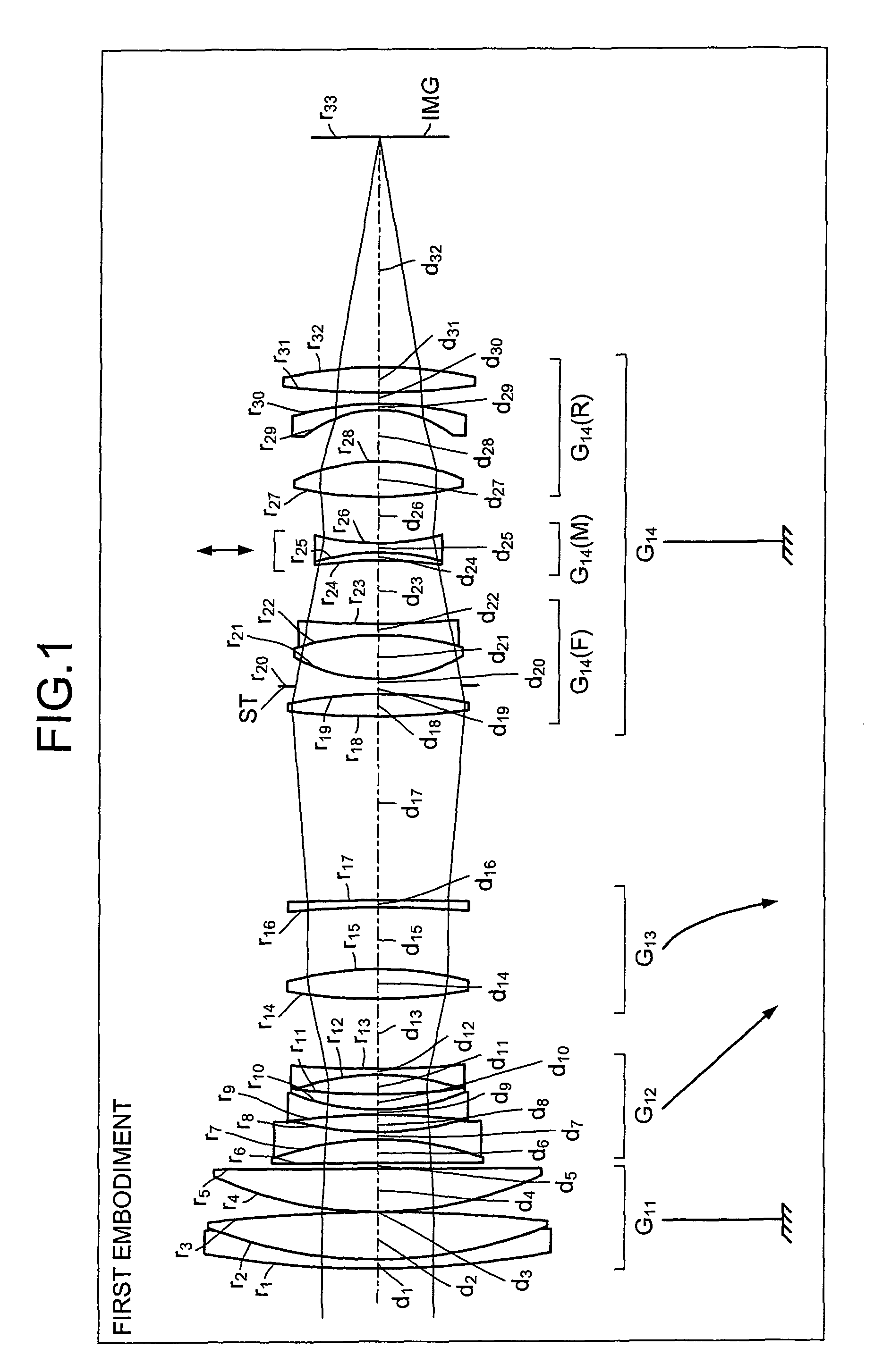Zoom lens
a zoom lens and lens body technology, applied in the field of zoom lenses, can solve the problems of anti-blur group, and large power consumption of the actuator
- Summary
- Abstract
- Description
- Claims
- Application Information
AI Technical Summary
Benefits of technology
Problems solved by technology
Method used
Image
Examples
first embodiment
[0042]FIG. 1 depicts a cross-sectional view (along the optical axis) of the zoom lens according to a The zoom lens includes sequentially from an object side (object not depicted), a first lens group G11 having a positive refractive power, a second lens group G12 having a negative refractive power, a third lens group G13 having a positive refractive power, and a fourth lens group G14 having a positive refractive power. Further, at an imaging plane IMG, the light receiving surface of an imaging element, such as a CCD and CMOS, is disposed.
[0043]The fourth lens group G14 consists of, sequentially from the object side, a front group G14(F) having a positive refractive power, an intermediate group G14(M) configured by a cemented lens formed by a positive lens and a negative lens and having an overall refractive power that is negative, and a rear group G14(R) having a positive refractive power. In the front group G14(F), an aperture stop ST prescribing a given aperture is disposed. Furth...
second embodiment
[0066]FIG. 5 depicts a cross-sectional view (along the optical axis) of the zoom lens according to a The zoom lens includes sequentially from an object side (object not depicted), a first lens group G21 having a positive refractive power, a second lens group G22 having a negative refractive power, a third lens group G23 having a positive refractive power, and a fourth lens group G24 having a positive refractive power. Further, at the imaging plane IMG, the light receiving surface of an imaging element, such as a CCD and CMOS, is disposed.
[0067]The fourth lens group G24 consists of, sequentially from the object side, a front group G24(F) having a positive refractive power, an intermediate group G24(M) configured by a cemented lens formed by a positive lens and a negative lens and having an overall refractive power that is negative, and a rear group G24(R) having a positive refractive power. In the front group G24(F), the aperture stop ST prescribing a given aperture is disposed. Fur...
third embodiment
[0088]FIG. 9 depicts a cross-sectional view (along the optical axis) of the zoom lens according to a The zoom lens includes sequentially from an object side (object not depicted), a first lens group G31 having a positive refractive power, a second lens group G32 having a negative refractive power, a third lens group G33 having a positive refractive power, and a fourth lens group G34 having a positive refractive power. Further, at the imaging plane IMG, the light receiving surface of an imaging element, such as a CCD and CMOS, is disposed.
[0089]The fourth lens group G34 consists of, sequentially from the object side, a front group G34(F) having a positive refractive power, an intermediate group G34(M) configured by a cemented lens formed by a negative lens and a positive lens and having an overall refractive power that is negative, and a rear group G34(R) having a positive refractive power. In the front group G34(F), the aperture stop ST prescribing a given aperture is disposed. Fur...
PUM
 Login to View More
Login to View More Abstract
Description
Claims
Application Information
 Login to View More
Login to View More - R&D
- Intellectual Property
- Life Sciences
- Materials
- Tech Scout
- Unparalleled Data Quality
- Higher Quality Content
- 60% Fewer Hallucinations
Browse by: Latest US Patents, China's latest patents, Technical Efficacy Thesaurus, Application Domain, Technology Topic, Popular Technical Reports.
© 2025 PatSnap. All rights reserved.Legal|Privacy policy|Modern Slavery Act Transparency Statement|Sitemap|About US| Contact US: help@patsnap.com



